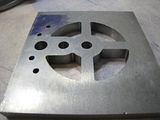- Joined
- Jun 24, 2010
- Messages
- 2,425
- Reaction score
- 959
I decided to make myself a stop for my milling vice. I came to realize I dont know much about milling slots. This one is 5/16" dia x 1.5" in about 3/4" thick steel. I didnt have a 2 flute 5/16" endmill but had a 4 flute 'centering' end mill the right size. I figured I would lighten the load to the endmill & remove some material by drilling a series of equally spaced undersized (1/4") holes in the slot area beforehand.
I positioned on one slot end circle, fed 0.050" depth, ran left to right, then down another 0.050", then right to left, back & forth like that. Aside from a bit of interrupted cutting on the holes, it cut ok, but was a pretty crappy finish (not pictured). I chocked this up to:
- maybe the material opening & closing (springing?) with the holes being exposed & intersected (although about 1/2" was contained in clamp jaws)
- maybe the holes were not perfectly centered & it was shifting the endmill
So, for education & experience, I used a next larger 11/32" endmill, again 4 flute centering. Started on one slot end, ran full depth, traversed the slot to the other side. A much better finish (pictured). But I still noticed some waviness & maybe even a slightly enlarged end hole.
Whats the proper procedure milling slots? Staged/progressively larger endmill diameters like a typcal hole drilling & reaming type principle? 2 flute endmill would be better? Maybe pre-holes like I did are a bad idea to begin with as the enmill edges catch the hole & make it drift slightly?Maybe good slot finish can only be accomplished by enlarging the slot width a thou or so to preferentially cut a side a prefertial rotation direction?



I positioned on one slot end circle, fed 0.050" depth, ran left to right, then down another 0.050", then right to left, back & forth like that. Aside from a bit of interrupted cutting on the holes, it cut ok, but was a pretty crappy finish (not pictured). I chocked this up to:
- maybe the material opening & closing (springing?) with the holes being exposed & intersected (although about 1/2" was contained in clamp jaws)
- maybe the holes were not perfectly centered & it was shifting the endmill
So, for education & experience, I used a next larger 11/32" endmill, again 4 flute centering. Started on one slot end, ran full depth, traversed the slot to the other side. A much better finish (pictured). But I still noticed some waviness & maybe even a slightly enlarged end hole.
Whats the proper procedure milling slots? Staged/progressively larger endmill diameters like a typcal hole drilling & reaming type principle? 2 flute endmill would be better? Maybe pre-holes like I did are a bad idea to begin with as the enmill edges catch the hole & make it drift slightly?Maybe good slot finish can only be accomplished by enlarging the slot width a thou or so to preferentially cut a side a prefertial rotation direction?



Last edited:

































































